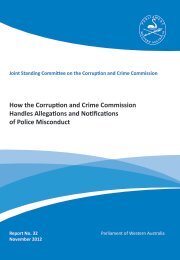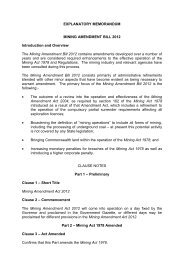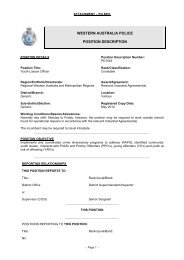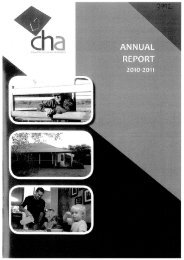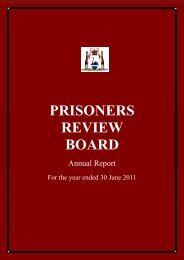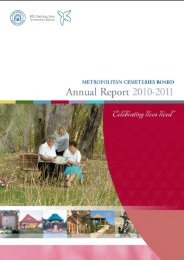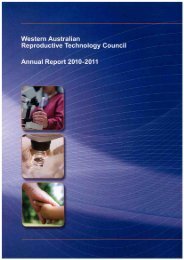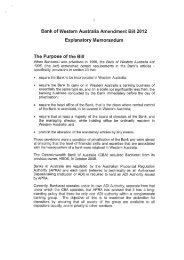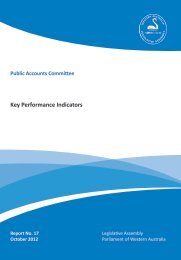Zoological Parks Authority - Parliament of Western Australia - The ...
Zoological Parks Authority - Parliament of Western Australia - The ...
Zoological Parks Authority - Parliament of Western Australia - The ...
You also want an ePaper? Increase the reach of your titles
YUMPU automatically turns print PDFs into web optimized ePapers that Google loves.
<strong>Zoological</strong> <strong>Parks</strong> <strong>Authority</strong> ANNUAL REPORT 2012<br />
Disclosures and Legal Compliance<br />
Financial Statements<br />
<strong>Zoological</strong> <strong>Parks</strong> <strong>Authority</strong><br />
Notes to the Financial Statements for the Year Ended 30 June 2012 continued<br />
(t)<br />
<strong>The</strong> GESB makes all benefit payments in respect <strong>of</strong> the Pension Scheme<br />
and GSS, and is recouped from the Treasurer for the employer’s share.<br />
<strong>The</strong> <strong>Authority</strong> also makes employer contributions to the Local Government<br />
Scheme which is administered by <strong>Western</strong> <strong>Australia</strong>n Local Government<br />
Superannuation. <strong>The</strong> liabilities for the current service superannuation<br />
charges under the Local Government Superannuation Scheme are<br />
extinguished by concurrent contributions made by the <strong>Authority</strong> to the fund<br />
Administrator.<br />
Refer also note 2(t) ‘Superannuation Expense’.<br />
(ii) Provisions – other<br />
Employment on-costs<br />
Employment on-costs, including workers’ compensation insurance, are<br />
not employee benefits and are recognised separately as liabilities and<br />
expenses when the employment to which they relate has occurred.<br />
Employment on-costs are included as part <strong>of</strong> ‘Other employee related<br />
expenses’ and are not included as part <strong>of</strong> the <strong>Authority</strong>’s ‘Employee benefits<br />
expense’. <strong>The</strong> related liability is included in ‘Employment on-costs provision’.<br />
Refer note 6 ‘Employee benefits expense’ and note 28 ‘Provisions’.<br />
Superannuation expense<br />
<strong>The</strong> superannuation expense in the Statement <strong>of</strong> Comprehensive Income<br />
comprises employer contributions paid to the GSS (concurrent contributions),<br />
WSS, GESBS, the <strong>Western</strong> <strong>Australia</strong>n Local Government Scheme (WALGS), or<br />
other superannuation fund.<br />
(u) Resources received free <strong>of</strong> charge or for nominal cost<br />
Resources received free <strong>of</strong> charge or for nominal cost that can be reliably<br />
measured are recognised as income at fair value. Where the resource received<br />
represents a service that the authority would otherwise pay for, a corresponding<br />
expense is recognised. Receipts <strong>of</strong> assets are recognised in the Statement <strong>of</strong><br />
Financial Position.<br />
Assets or services received from other State Government agencies are<br />
separately disclosed under Income from State Government in the Statement<br />
<strong>of</strong> Comprehensive Income.<br />
78<br />
(v) Comparative figures<br />
Comparative figures are, where appropriate, reclassified to be comparable with<br />
the figures presented in the current financial year.<br />
(w) Segment information<br />
Segment information is prepared in conformity with the accounting policies <strong>of</strong><br />
the <strong>Authority</strong> and the segment reporting requirement <strong>of</strong> TI 1101.<br />
Segment information has been disclosed by services – refer note 34 ‘Schedule<br />
<strong>of</strong> income and expenses by service’.<br />
3. Judgements made by management in applying accounting policies<br />
<strong>The</strong> preparation <strong>of</strong> financial statements requires management to make<br />
judgements about the application <strong>of</strong> accounting policies that have a significant<br />
effect on the amounts recognised in the financial statements. <strong>The</strong> <strong>Authority</strong><br />
evaluates these judgements regularly and the judgements made in the process<br />
<strong>of</strong> applying accounting policies that have the most significant effect on the<br />
amounts recognised in these financial statements include:<br />
– Adopting cost model for plant, equipment and infrastructure valuation.<br />
– Adopting revaluation model for land, building and works <strong>of</strong> art valuation.<br />
– Application <strong>of</strong> stage <strong>of</strong> completion method for determining unearned revenue.<br />
4. Key sources <strong>of</strong> estimation uncertainty<br />
Key estimates and assumptions concerning the future are based on historical<br />
experience and various other factors that have a significant risk <strong>of</strong> causing a<br />
material adjustment to the carrying amount <strong>of</strong> assets and liabilities within the<br />
next financial year.<br />
Long service leave<br />
Several estimations and assumptions used in calculating the <strong>Authority</strong>’s long<br />
service leave provision include expected future salary rates, discount rates,<br />
employee retention rates and expected future payments. Changes in these<br />
estimations and assumptions may impact on the carrying amount <strong>of</strong> the long<br />
service leave provision.



